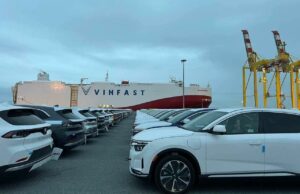
Interest in EV purchases has doubled year-over-year, study shows
By onMarket Trends
More than half of internal combustion engine (ICE) drivers within the U.S. would be interested in having their next vehicle be electric, a new study by VinFast and The Harris Poll found.
The study examining U.S. drivers’ electric vehicle (EV)-related beliefs, experiences, and behaviors found that 54% of ICE drivers are keen to make the switch and that 85% of current EV drivers would likely purchase or lease another EV if it offered all their desired features.
When paired with a July 2022 AAA study, which found about one-quarter of drivers were likely to make an EV their next auto purchase, the VinFast/Harris study indicates demand for EVs has doubled year-over-year.
However, with just 9% of study respondents currently driving an EV, it also shows the industry has a long way to go before reaching wide-scale adoption.
Environmental considerations were a main driving force among those interested in buying an EV for their next purchase, with 70% of respondents agreeing that they’re a key part of a greener future. Lengthy warranties were another selling point, with 76% of drivers saying they’d be more likely to buy an EV if it included an extended or unlimited battery warranty.
As it relates to price, gas savings trumped cost concerns, with 62% of survey respondents saying they’d buy or lease an EV to save money at the pumps. About 55% of ICE drivers said affordability was one factor dissuading them from buying an EV.
According to the 1,800 U.S. adults surveyed, the most popular features being sought in a new EV include:
-
- Affordability (58%):
- Charging convenience (54%);
- Safety (45%);
- Warranty and service (35%);
- Driving technology (23%); and
- Visual design (16%).
Availability of seating options was another priority among 48% of respondents, followed by more storage (47%), body styles (46%), and colors (17%).
VinFast partnered on the study as it seeks to grow its market share in the U.S.
The Vietnam-headquartered automaker delivered its first batch of cars to the U.S. in March. In July, construction began for its North Carolina production facility designed to reach a capacity of 150,000 vehicles per year.
A spokesman told Repairer Driven News that VinFast’s initial orders are slated for the U.S. market and that a monthly production estimate will be released at a later date.
It’s expected that the factory will open in 2025. Monthly projections are dependent on demand and the month it begins production.
Some repairers are preparing for VinFast’s growth by joining its certified repair network, including an Atlantic Canada facility that became certified earlier this year to meet anticipated demand.
Kelvin Campbell, who runs the Chapman Auto Body team in Nova Scotia, is now encouraging other repair centers to join EV certification networks to remain competitive amid growing demand.
“For the foreseeable future, I think electric conversation is going to stick around for a long time,” Campbell said. “If your shops are not ready for electric… [and] if you’re in it for the long-term, I think you need to start really looking at electric and posturing for the future. As a shop owner, you should definitely be looking at upgrading shops, and at the very least, have some sort of repair procedures on electric vehicles.”
Remaining profitable amid the shifting landscape is just one reason for facility preparation, Campbell said, adding safety is another concern businesses must take into consideration.
“It’s very dangerous for the technician to work on,” Campbell said. “You need to have the right equipment and you need to be prepared for whatever type of repair that you have to do.”
VinFast said in May that I-CAR’s Gold Class shop-level credentialing will be a requirement for its U.S. repair network. I-CAR will provide VinFast’s Certified Collision Network with technical education including welding certifications, including:
A VinFast spokesman told RDN that it typically takes between one and three months for a shop to become a certified OEM facility and that the variance is a result of requirements in the onboarding process. As with other automakers, this includes training, equipment audits, inspections, and other measures.
Canadian collision facilities are required to submit online applications here while U.S. businesses can get started here.
“Returning a vehicle to pre-accident condition is the goal of any OEM-certified collision center repair program. This is to make sure that the vehicle will perform to VinFast standards when a second collision happens,” VinFast’s spokesman said. “It’s important for vehicle owners to feel confidence in their repaired vehicle and the quality of a collision repair is what determines how effective an outcome will be. This is also to ensure the peace of mind and satisfaction for vehicle owners when using the repaired cars.”
Images
Main image: The first batch of VinFast EVs lined up for export at Haiphong, Vietnam. (Provided by VinFast)
